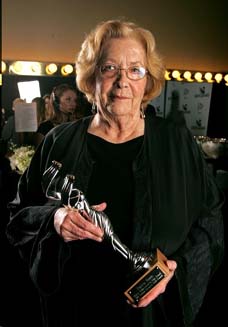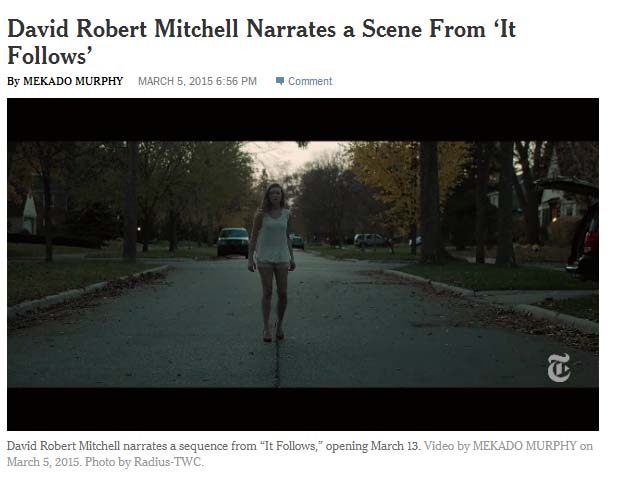COSTUME DESIGNER PATRICIA NORRIS DIES
DESIGNED COSTUMES FOR 'SCARFACE', ALSO PRODUCTION DESIGNER ON 'SINGING DETECTIVE' Patricia Norris
Patricia Norris, the costume designer for
Brian De Palma's
Scarface, passed away February 20 of natural causes,
Variety reported today. She was 83. Norris was nominated for Oscars six times in her lifetime. She worked regularly with
David Lynch, and was both the production designer and the costume designer on
Keith Gordon's 2003 film adaptation of
The Singing Detective. A year ago, around the time of her Oscar nomination for costume design on
Steve McQueen's
12 Years A Slave, Norris told
The Film Experience's Nathaniel R that on
Scarface, De Palma and producer
Martin Bregman "knew exactly what they wanted." She added that
Michelle Pfeiffer helped make the costumes iconic. "She's a beautiful girl and it was perfect for the character."
Norris is quoted several times about the making of
Scarface in
Ken Tucker's 2008 book,
Scarface Nation:
ON FILMING IN MIAMI, AMIDST THREATS FROM LOCAL COMMUNITY
"I did think they'd have killed us if we'd stayed in Miami. There were members of the community who hated us because they thought we were doing a pro-Castro movie, which was absurd, but their anger was very serious. And then there were real drug people around. Colombians who came on the set. The day a fellow sat down in the chair next to me, and crossed his legs, and I saw a gun strapped to his ankle, I knew I wanted to get back to Los Angeles. Thank God we did, within two weeks."
ON STAR AL PACINO
"Pacino was very nice. I had been told he was going to stay in character and all that, so I was prepared for it." Tucker writes that Pacino spoke to Norris with his Cuban accent, even through his wardrobe fittings.
REGARDING THE TENSION, EGO CLASHES ON THE SET OF 'SCARFACE'
 "Let me put it this way. After Scarface, I almost didn't want to work in the movies again. You're making a movie that's not about nice people, being made by people many of whom aren't nice people... It was tense, pretty distant. I don't like being condescended to. I worked with David Lynch for over twenty-five years because he was a nice person and an artist, and he appreciates the artistry other people bring to their work.
"Let me put it this way. After Scarface, I almost didn't want to work in the movies again. You're making a movie that's not about nice people, being made by people many of whom aren't nice people... It was tense, pretty distant. I don't like being condescended to. I worked with David Lynch for over twenty-five years because he was a nice person and an artist, and he appreciates the artistry other people bring to their work.
"I didn't get that feeling with De Palma. He was tense a lot of the time; he could be cold and rude, dismissive. I don't think he liked clothes. I shouldn't say that-- the only clothes he was interested in were the women's clothes, Michelle's clothes. He and Marty Bregman both. They wanted a lot of input in how she should look-- it was more than a little creepy, if you ask me. I'd overhear them arguing about how she should be dressed, how sexy, how much skin they wanted her to show."
 The March 2015 issue of EMPIRE magazine, on stands now in the U.S., includes a one-page C.V. in which John Lithgow discusses his signature roles. Under the heading, "His Biggest Challenge," is Brian De Palma's Raising Cain, with the characters listed as "Carter/Cain/Dr. Nix/Josh/Margo, deranged doctor and his brood." Of his role(s) in the film, Lithgow tells EMPIRE, "The most plot-heavy film I've been in. It was only two characters, and yet you wanted to fool people into thinking it was three or four. The rehearsal period was simply charting the crazy."
The March 2015 issue of EMPIRE magazine, on stands now in the U.S., includes a one-page C.V. in which John Lithgow discusses his signature roles. Under the heading, "His Biggest Challenge," is Brian De Palma's Raising Cain, with the characters listed as "Carter/Cain/Dr. Nix/Josh/Margo, deranged doctor and his brood." Of his role(s) in the film, Lithgow tells EMPIRE, "The most plot-heavy film I've been in. It was only two characters, and yet you wanted to fool people into thinking it was three or four. The rehearsal period was simply charting the crazy."








 Patricia Norris, the costume designer for Brian De Palma's Scarface, passed away February 20 of natural causes,
Patricia Norris, the costume designer for Brian De Palma's Scarface, passed away February 20 of natural causes,  "Let me put it this way. After Scarface, I almost didn't want to work in the movies again. You're making a movie that's not about nice people, being made by people many of whom aren't nice people... It was tense, pretty distant. I don't like being condescended to. I worked with David Lynch for over twenty-five years because he was a nice person and an artist, and he appreciates the artistry other people bring to their work.
"Let me put it this way. After Scarface, I almost didn't want to work in the movies again. You're making a movie that's not about nice people, being made by people many of whom aren't nice people... It was tense, pretty distant. I don't like being condescended to. I worked with David Lynch for over twenty-five years because he was a nice person and an artist, and he appreciates the artistry other people bring to their work.
 In an interview with
In an interview with